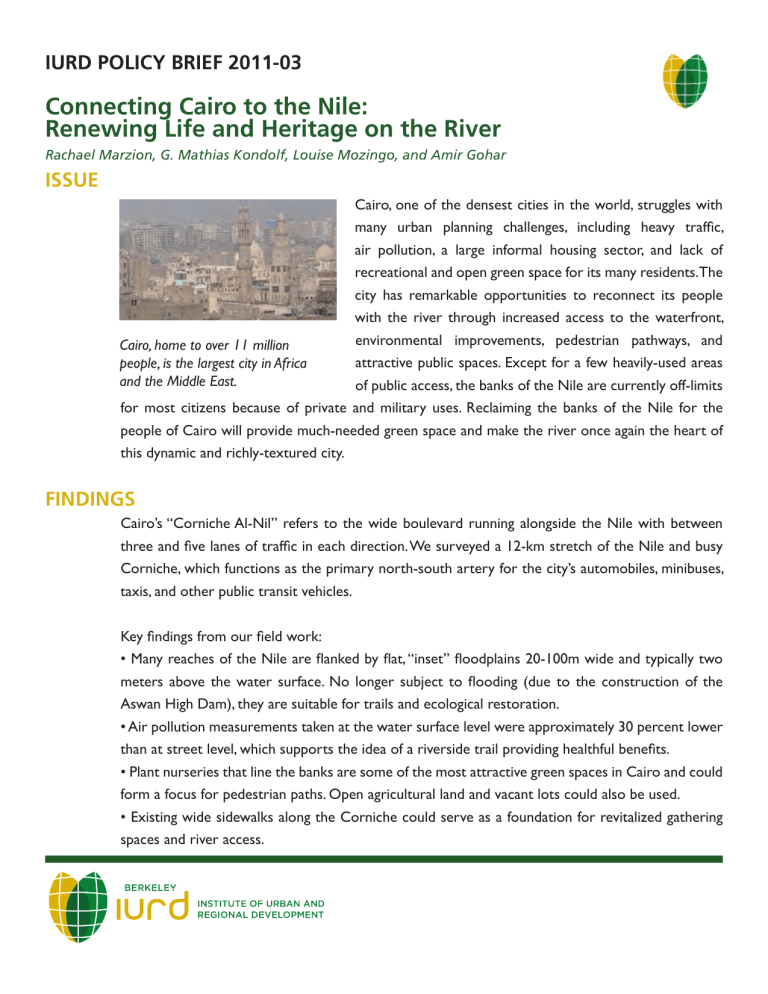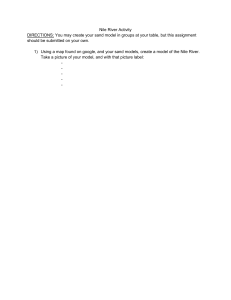
IURD POLICY BRIEF 2011-03 Connecting Cairo to the Nile: Renewing Life and Heritage on the River Rachael Marzion, G. Mathias Kondolf, Louise Mozingo, and Amir Gohar ISSUE Cairo, one of the densest cities in the world, struggles with many urban planning challenges, including heavy traffic, air pollution, a large informal housing sector, and lack of recreational and open green space for its many residents.The city has remarkable opportunities to reconnect its people with the river through increased access to the waterfront, environmental improvements, pedestrian pathways, and Cairo, home to over 11 million attractive public spaces. Except for a few heavily-used areas people, is the largest city in Africa and the Middle East. of public access, the banks of the Nile are currently off-limits for most citizens because of private and military uses. Reclaiming the banks of the Nile for the people of Cairo will provide much-needed green space and make the river once again the heart of this dynamic and richly-textured city. FINDINGS Cairo’s “Corniche Al-Nil” refers to the wide boulevard running alongside the Nile with between three and five lanes of traffic in each direction. We surveyed a 12-km stretch of the Nile and busy Corniche, which functions as the primary north-south artery for the city’s automobiles, minibuses, taxis, and other public transit vehicles. Key findings from our field work: • Many reaches of the Nile are flanked by flat, “inset” floodplains 20-100m wide and typically two meters above the water surface. No longer subject to flooding (due to the construction of the Aswan High Dam), they are suitable for trails and ecological restoration. • Air pollution measurements taken at the water surface level were approximately 30 percent lower than at street level, which supports the idea of a riverside trail providing healthful benefits. • Plant nurseries that line the banks are some of the most attractive green spaces in Cairo and could form a focus for pedestrian paths. Open agricultural land and vacant lots could also be used. • Existing wide sidewalks along the Corniche could serve as a foundation for revitalized gathering spaces and river access. • Public use of the limited ferry routes along the river illustrates the potential the Nile holds to function as a significant public transportation corridor if the city is able to expand the existing ferry system. • Many waterfront locations afford unobstructed views of local landmarks, and city residents are interested in recreational and social opportunities near the waterfront. • Some public and private land users would need to be relocated or reorganized to accommodate a riverside trail. • Institutional support is needed to resolve many existing environmental issues, notably traffic and waste disposal. • Housing developments arise adjacent to irrigation canals and lack formal connections to water and sewer facilities. RECOMMENDATIONS We identified some fundamental recommendations that could guide any renewal effort of the Nile: • Establish a longitudinally continuous pedestrian/bicycle trail network along the river, including lateral connectivity to important cultural, commercial, and tourist nodes. • Leverage and expand the current transportation system. Metro stations and dilapidated ferry landings exist within walking distance of the Nile, and buses currently run north to south. Revitalized ferry terminals and transit stations could bring additional users to the river and alleviate traffic and air pollution. • Develop an open space network and create walkable connections between the river, transit nodes, and landmarks to allow city residents and tourists to experience the Nile waterfront. The study area included a 12-km stretch of the Nile in central Cairo from the Central The Nile River can be the fundamental, unifying structure in the Business District to the regeneration of Cairo’s civic spaces. In a new period in history, it southern suburb of Maadi. can serve the city’s citizens in ways that can transform everyday urban experiences for the better and have economic benefits for the private sector. It provides a tremendous opportunity to be a global model for a river renewed. This policy brief is a product of the Institute of Urban and Regional Development located at UC Berkeley: 316 Wurster Hall, Berkeley, CA, 94720-1870. It is drawn from the full report, George Mathias Kondolf, Louise Mozingo, Rachael Marzion, Krishna Balakrishnan, Amir Gohar, et al., Connecting Cairo to the Nile: Renewing Life and Heritage on the River. IURD Working Paper 2011-06. For a PDF of full report, go to: www.iurd.berkeley.edu/publications/wp/2011-06.pdf. For a PDF of this Policy Brief, go to www.iurd.berkeley.edu/publications/policybriefs/IURD-PB-2011-03.pdf. Or visit the UC eScholarship repository, www.escholarship.org/uc/iurd. © 2011 UC Regents.


